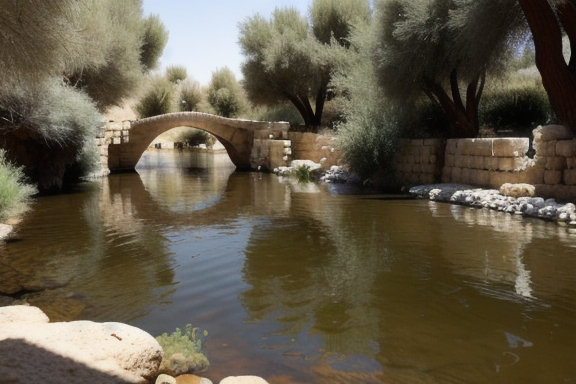The Baptism of Jesus
The baptism of Jesus holds great significance in Christian theology, marking the beginning of his public ministry and symbolizing his identification with humanity. It is a pivotal event that reveals Jesus’ humility, obedience, and his role as the Messiah.
**According to the Bible**, Jesus was baptized by John the Baptist in the Jordan River. John’s baptism was a baptism of repentance, symbolizing a turning away from sin and a desire to live a righteous life. However, **Jesus, being sinless**, did not need to repent. His baptism was unique and carried a different meaning.
The **age of Jesus at the time of his baptism** is not explicitly mentioned in the Bible. However, based on the information provided, scholars estimate that Jesus was around **thirty years old** when he was baptized. This aligns with the age at which Jewish men would begin their public ministry and assume religious responsibilities.
The Significance of Jesus’ Baptism
Jesus’ decision to be baptized by John holds deep theological significance. It serves as a powerful demonstration of his identification with humanity and his willingness to fulfill God’s plan for salvation. Through his baptism, Jesus publicly declares his commitment to God’s will and his role as the Messiah.
**The baptism of Jesus also foreshadows his future crucifixion and resurrection**. As Jesus emerges from the water, the Holy Spirit descends upon him in the form of a dove, and a voice from heaven proclaims, “**This is my beloved Son, with whom I am well pleased**” (Matthew 3:17). This divine affirmation confirms Jesus’ identity as the Son of God and sets the stage for his redemptive mission.
The Location of Jesus’ Baptism
The Bible states that Jesus was baptized in the Jordan River. The exact location has been a subject of debate and speculation. **One possible location is Al-Maghtas**, a site on the east bank of the Jordan River, near the modern-day border between Jordan and Israel. This location has been recognized as a UNESCO World Heritage Site and is considered one of the potential sites for Jesus’ baptism.
**The archaeological evidence discovered at Al-Maghtas** supports the biblical account of baptism rituals taking place in this area during the time of Jesus. Pilgrims have been visiting this site for centuries, seeking to connect with the profound spiritual significance of Jesus’ baptism.

Curiosities and Less-Known Facts
– **The baptism of Jesus marks the beginning of his public ministry**, which includes miracles, teachings, and ultimately, his sacrificial death on the cross.
– **John the Baptist, Jesus’ cousin**, played a significant role in preparing the way for Jesus’ ministry through his preaching of repentance and baptism.
– **The baptism of Jesus was a Trinitarian event**, with the Father speaking from heaven, the Holy Spirit descending like a dove, and Jesus being baptized.
– **By being baptized, Jesus identifies with humanity** and sets an example for believers to follow.
– **Jesus’ baptism is considered a sacrament** in many Christian traditions, symbolizing initiation into the community of faith.
– **The baptism of Jesus is celebrated annually** in various Christian denominations through the observance of the Feast of the Baptism of the Lord.
Biblical Accounts of Jesus’ Baptism
The baptism of Jesus is a significant event in the life of Jesus Christ, marking the beginning of his public ministry. The four Gospels – Matthew, Mark, Luke, and John – each provide their own unique accounts of this pivotal moment in Jesus’ life.
The Gospel of Matthew’s Account
In the Gospel of Matthew, the baptism of Jesus is described in Matthew 3:13-17. John the Baptist plays a central role in this account, baptizing Jesus in the River Jordan. As Jesus comes up out of the water, the heavens open, and the Spirit of God descends like a dove, resting upon him. A voice from heaven declares, “This is my Son, whom I love; with him, I am well pleased.” This divine affirmation marks the beginning of Jesus’ public ministry and affirms his identity as the Son of God.
The Gospel of Mark’s Account
In the Gospel of Mark, the baptism of Jesus is described in Mark 1:9-11. Mark’s account closely parallels Matthew’s account, highlighting the role of John the Baptist and the descent of the Holy Spirit. However, Mark’s account emphasizes the immediacy of Jesus’ baptism and the subsequent vision. After Jesus is baptized, he sees the heavens being torn open, and the Spirit descending upon him like a dove. Again, a voice from heaven proclaims, “You are my Son, whom I love; with you, I am well pleased.” This powerful moment confirms Jesus’ divine calling and sets the stage for his ministry.
The Gospel of Luke’s Account
The Gospel of Luke provides additional details about the baptism of Jesus in Luke 3:21-22. Luke notes that Jesus was baptized along with many others by John the Baptist. When Jesus was baptized and praying, the heavens open, and the Holy Spirit descends upon him in bodily form like a dove. The voice from heaven echoes the previous accounts, saying, “You are my Son, whom I love; with you, I am well pleased.” Luke’s account emphasizes the importance of prayer and the role of the Holy Spirit in Jesus’ baptism.
The Gospel of John’s Account
The Gospel of John mentions the baptism of Jesus indirectly in John 1:29-34. Instead of providing a detailed narrative, John the Baptist testifies about Jesus, saying, “Look, the Lamb of God, who takes away the sin of the world!” John identifies Jesus as the one who surpasses him, stating that he saw the Spirit descending and remaining on Jesus, confirming that he is the Son of God. While John’s account does not describe the baptism event itself, it emphasizes the role of Jesus as the Savior and the Lamb of God.
Historical and Theological Perspectives
The baptism of Jesus holds significant importance in both historical and theological contexts. The event is recorded in the Gospels of Matthew, Mark, Luke, and John, providing different perspectives on this momentous occasion. These accounts offer insights into the interpretations of Jesus’ baptism and shed light on the role of baptism in Christian theology.
Interpretations of Jesus’ Baptism
The baptism of Jesus has been interpreted in various ways throughout history. Some view it as a symbolic act of Jesus identifying with humanity and inaugurating his ministry. Others see it as an act of submission to John the Baptist’s message and an example of righteousness. **Regardless of the interpretation, Jesus’ baptism marks a significant turning point in his life and ministry.**
One interpretation focuses on the concept of Jesus taking on the sins of humanity through his baptism. This act is seen as a foreshadowing of his sacrificial death on the cross. **By being baptized, Jesus demonstrates his willingness to embrace humanity’s brokenness and offer redemption through his ultimate sacrifice.**
The Role of Baptism in Christian Theology
Baptism holds a central place in Christian theology, signifying initiation into the faith and symbolizing spiritual rebirth. It is considered a sacrament in many Christian traditions, including Catholicism, Orthodox Christianity, and Protestant denominations. **Through baptism, believers are united with Christ and become part of the body of believers, the Church.**
Christian theology emphasizes that baptism is not merely a ritual but a transformative experience. It represents the forgiveness of sins, the gift of the Holy Spirit, and a new life in Christ. **The act of immersion or sprinkling with water symbolizes purification and spiritual cleansing.** Baptism is seen as a public declaration of one’s faith and commitment to follow Jesus.
The Symbolism of Water in Baptism
In the biblical context, water holds profound symbolism in relation to baptism. Water is often associated with purification, renewal, and life-giving properties. **The act of being immersed in water signifies dying to one’s old self and rising to new life in Christ.** It symbolizes a washing away of sins and a spiritual rebirth.
Water is also closely linked to the concept of the Holy Spirit. In the accounts of Jesus’ baptism, the Holy Spirit descends upon him like a dove. This event further reinforces the connection between baptism, the Holy Spirit, and the empowering presence of God in the believer’s life. **The symbolism of water in baptism reminds Christians of God’s grace, cleansing, and renewal.**

FAQ: Frequently Asked Questions
| Question | Answer |
|---|---|
| 1. Is baptism necessary for salvation? | Baptism is considered an important sacrament in Christianity, but different denominations have varying beliefs on its necessity for salvation. Some view it as essential, while others emphasize that salvation comes through faith in Jesus Christ. |
| 2. Can infants be baptized? | Infant baptism is practiced in many Christian traditions, particularly in Catholicism and Orthodox Christianity. It signifies the child’s entrance into the Christian community and the promise of faith by their parents or guardians. |
| 3. Can someone be baptized more than once? | Christian denominations hold different views on this matter. Some believe that baptism is a one-time event, while others allow for multiple baptisms in cases where individuals experience a significant spiritual renewal or change in their faith. |

Rockin’ the faith, one verse at a time!
Growing up, the Bible’s stories deeply impacted me. Now, with over 15 years of preaching experience, I blend timeless teachings with modern technology, making them relevant for today’s world.
Bible Hub Verse is my platform to share historical insights and thought-provoking articles, exploring both familiar and uncommon Christian topics. My passion is building a welcoming online space for everyone to learn, grow in their faith, and discover the Bible’s enduring message.
Join the journey!
God bless you.







